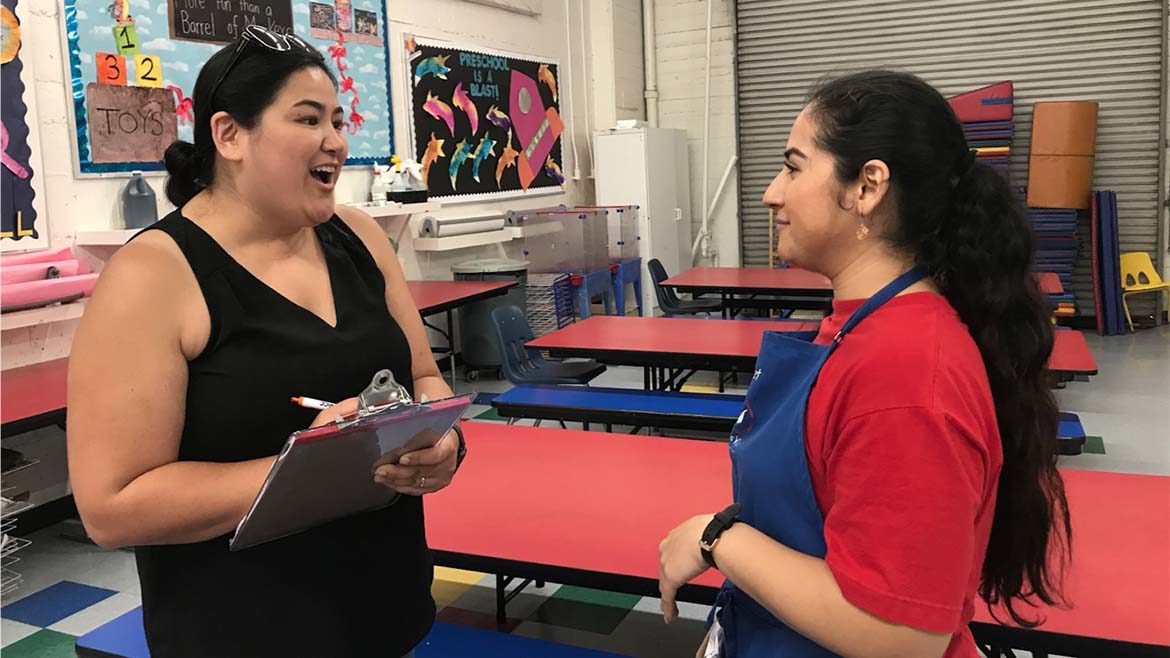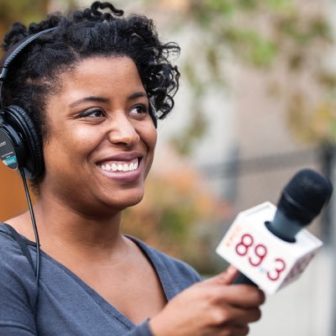To redesign education coverage, start by doing your homework

SCPR
Ashley Alvarado of Southern California Public Radio interviews a preschool teacher in Pasadena, Calif.
When California Gov. Gavin Newsom took office in January 2019, he declared early childhood education his priority. The news came as no surprise to the news team at KPCC in Pasadena; we first assigned a reporter to cover early education in 2012. And we were a little lonely in the beat.
That’s because education coverage usually focuses on K-12, despite the fact that 85 percent of brain development occurs in the first three years. What happens to children ages 0–5 affects outcomes later in life, like incarceration rates and career opportunities. In our first six years of covering early education, we produced more than 800 early childhood stories and convened more than a dozen in-person conversations to bring together experts and stakeholders.
Despite our progress, we recognized a larger opportunity. We asked ourselves: What would happen if we were more intentional in how we defined our audience? Instead of describing the audience as “anyone who listened or read KPCC stories,” what if we redefined it as parents and caregivers of children ages 0–5 in Los Angeles County? Would it change the stories we told? The ways we told them?
Before we could answer any of these questions, we had to do our homework. We turned to design thinking to better understand parents’ and caregivers’ information needs and habits.
Design thinking is a methodology for problem-solving that forces you to identify actual problems before offering solutions. As Hearken CEO and co-founder Jennifer Brandel has written, “At its most basic, design thinking is an agile process for solving complex problems. It’s a way of understanding the needs of the people you’re building a solution for, and testing that solution with them before creating it.”
We launched a five-step process:
- Development of stakeholder map and target characteristics
- Stakeholder interviews
- Synthesis
- Brainstorming
- Development of potential prototypes
This approach involved interviewing stakeholders — people who spend a significant part of their day engrossed in early childhood development — with significantly different target characteristics identified through reporter Priska Neely’s coverage of early childhood (high-income, low-income, English-dominant, non–English-speaking, etc.).

In addition to Neely and me, our research team included Chief Content Officer Kristen Muller, Human-centered Design Specialist Tran Ha, and interns Natalie El-Hai and Jane Jozefowicz.
Traditionally, when journalists are on deadline, we ask subjects very direct questions that need a precise answer. With our approach, we employed more open-ended questions like “What do you worry about when it comes to your children?” and “If you had more time in the day, how would you use it?” as well as the observation of body language. This is to draw out implicit needs, in addition to explicit ones.
Explicit needs are what we can see: our conscious decisions and behaviors that we can observe and discuss. Implicit needs lie below the surface and include emotions, values, and beliefs. Implicit needs are harder to observe, but they often provide deeper insight and focus.
After completing the interviews, we worked with a design thinking specialist to identify patterns and themes in the interviews and observations. This synthesis allowed us to identify archetypes within our target audience as well as key insights that will drive our next phase of early childhood reporting and engagement.
We identified four archetypes:
- Conspicuous Consumer — Likely part of KPCC’s existing audience, the Conspicuous Consumer needs information to feed curiosity, improve quality of life and reinforce world views.
- Conscientious Caregiver — Less likely to be a regular KPCC listener, the Conscientious Caregiver needs information to inform their mission-driven work in the early childhood sector or to navigate the services designed for parents and caregivers.
- Busy Bootstrapper — Completely outside of KPCC’s existing reach, the Busy Bootstrapper needs information to survive and connect to resources.
- Passive Follower — Unlikely to be a regular KPCC listener, the Passive Follower has experienced financial insecurity but not so much as to search out information in the way the Busy Bootstrapper does.
Three key insights will guide our work going forward:
- Formal and informal networks play important roles in collecting and disseminating information.
- Many parents are worried about their kids’ long-term futures instead of their developmental needs at ages 0–5.
- Some face additional learning curves and burdens in navigating the early childhood education and development system.
KPCC recognizes the greatest opportunity to expand its reach and deepen its impact in a meaningful way is with the Busy Bootstrapper and Conscientious Caregiver archetypes.
To really tap into the networks and informal distribution models we know exist, we must do much of this work in person. We cannot rely on our radio and digital platforms. At the same time, we cannot — and will not — stop doing the journalism that serves the Conspicuous Consumer. This is not a technology solution. Instead, it is low-tech and high-touch.
We brainstormed potential news services that could reach Busy Bootstrappers and Conscientious Caregivers and enhance the strength of our journalism. We identified a high-touch, low-tech approach with community engagement at its core.
Coming out of the synthesis process, we hired Stefanie Ritoper as our first-ever early-childhood engagement producer and selected three ideas to prototype over the next two years:
- Printed fliers in libraries and parks — KPCC has begun distributing paper materials through informal partnerships and direct mail. This is an effort to meet people where they are with the information they have said they need.
- Early childhood ambassador program — This prototype is designed to facilitate connections with all four archetypes, since people in each group have different degrees of familiarity with KPCC. Through deep engagement, this prototype helps KPCC journalists better understand and meet the information needs of each archetype.
- Children’s book clubs at public libraries — This prototype is designed to reach those we would classify in the Conspicuous Consumer, Conscientious Caregiver and Busy Bootstrapper archetypes. We have begun looking at ways to leverage our existing relationships and those of parents and caregivers with public libraries to meet people where they already convene and seek out information and events.
Early results demonstrate a clear early win with a January event focused on black infant mortality rates. More than 400 people registered for the event, and roughly 200 people turned out, which was double our goal for attendance. We had to open an overflow room to accommodate everyone. More than 90 percent of the audience presented as black women, including high school students, grandmothers, medical professionals and others.
We promoted the event by circulating postcards that included a unique URL for the landing page for our coverage on black infant mortality. An early review of the website analytics indicates that about 330 unique visitors came to the landing page from the URL on the postcards. Roughly 51 percent of all people who registered for the event said they had heard about it in a way other than our traditional outreach model.
As the policy debates over early childhood education continue to intensify in California, it is critical that our reporting reflects the concerns of the people who are affected the most: parents and caregivers who are steeped in early childhood work. We are eager to start informing, connecting and convening these stakeholders, especially those who are not already familiar with KPCC or NPR.
It is our hope that our successes (and, possibly, failures) will accelerate the field of learning so that public radio can play a more active role in engaging new audiences. The homework continues.
Ashley Alvarado is director of community engagement at KPCC. She also serves as mentor of the Membership Puzzle Project’s Join the Beat cohort, as board president of Journalism That Matters, on the steering community of Gather, and as a curator for BetterNews.org. This essay was adapted from a Medium post.





